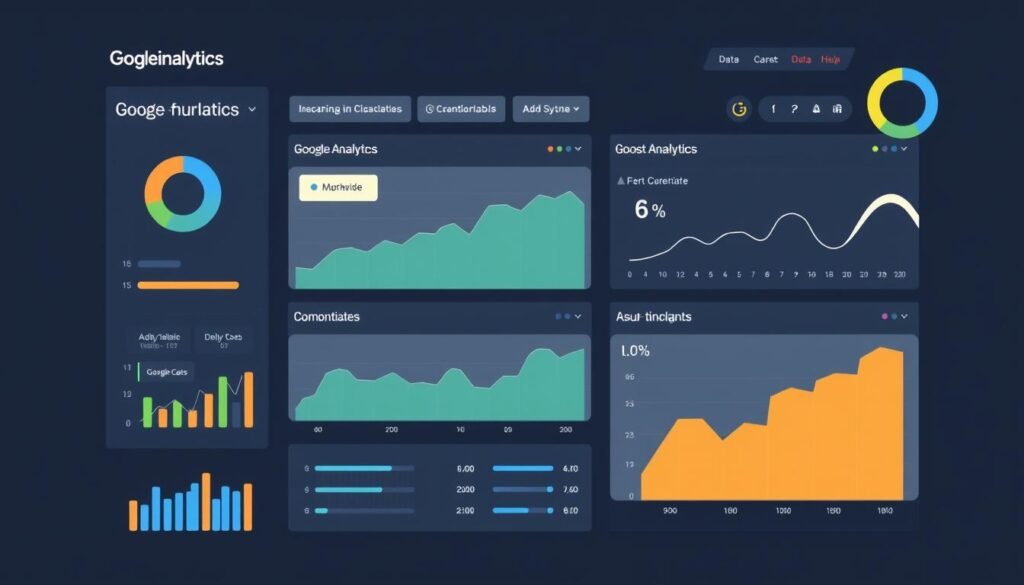In today’s fast-paced digital landscape, capturing and maintaining your target audience’s attention is more challenging than ever. With the average consumer exposed to countless brand messages daily, simply having an online presence isn’t enough; you need to actively engage your audience to stand out.
Effective audience engagement involves creating meaningful interactions between your brand and its target audience across various digital platforms. By doing so, you can foster genuine connections that lead to lasting brand loyalty and improved business outcomes. For more insights on enhancing your online presence, check out proven ways to engage your audience with digital and explore the impact of digital marketing on various.
Key Takeaways
- Understand the fundamentals of audience engagement to create effective strategies.
- Learn how to measure engagement success using key metrics and analytics tools.
- Discover techniques to transform casual browsers into loyal customers and brand advocates.
- Explore how to create meaningful connections with your audience across digital platforms.
- Develop a clear roadmap for maximizing your digital audience engagement.
What is Digital Audience Engagement?
Understanding digital audience engagement is crucial for any brand looking to thrive online. In today’s digital landscape, your audience is constantly bombarded with content, making it challenging to capture their attention and foster meaningful interactions.
Digital audience engagement refers to the connection your audience feels with your brand and the actions they take as a result of it. It’s about creating a two-way communication channel where your audience doesn’t just passively consume content but actively participates through various actions.
Defining Audience Engagement in the Digital Space
Audience engagement in the digital space goes beyond simple metrics like views or impressions. It encompasses the meaningful interactions between your brand and target audience across various online platforms, including social media and your website. At its core, engagement is about creating a dialogue with your audience, encouraging them to interact with your content through likes, comments, shares, and other actions.
The digital space offers unique opportunities for engagement that weren’t possible with traditional marketing, including real-time interactions and personalized experiences. By leveraging these opportunities, you can build a loyal community around your brand.
Types of Audience Engagement
There are various types of audience engagement, each providing different value to your marketing efforts. These include:
- Likes and reactions, which increase visibility and show appreciation for your content.
- Comments and replies, which offer deeper insights into audience preferences and behavior.
- Shares and resharing, which amplify your content’s reach and indicate a higher level of engagement.
- Reviews and mentions, which provide valuable feedback and can influence others’ perceptions of your brand.
- Website interaction, such as time spent on site and pages per session, which indicates how engaging your content is.
Recognizing which types of engagement align with your specific marketing goals will help you develop more targeted and effective content strategies. By understanding and leveraging these different types of engagement, you can maximize your digital audience engagement and drive meaningful results for your brand.
Why Marketing Digital Audience Engagement Matters
To stand out in the crowded digital space, engaging your audience is not just beneficial, it’s essential. Your brand doesn’t exist in a vacuum, and without a solid digital audience engagement strategy, your digital marketing efforts may fall flat.
Audience engagement is crucial because it directly impacts your brand’s visibility, customer loyalty, and ultimately, your bottom line. When your audience engages with your brand, especially more than once, they are more likely to stick around for the long term.
Increasing Brand Loyalty and Trust
Consistent engagement helps build trust with your audience, creating an emotional connection that makes them more likely to choose your brand over competitors. Building trust through engagement is key to fostering brand loyalty, leading to repeat business and positive word-of-mouth.
Boosting Visibility and Reach
Social media algorithms reward audience engagement by displaying your content to more people. When your audience actively engages with your content, you gain greater visibility, effectively amplifying your message to reach new potential customers.
Gaining Valuable Customer Feedback
Engaged audiences provide invaluable feedback, both direct and indirect, helping you refine your products, services, and marketing approaches to better meet customer needs. This feedback loop is essential for continuous improvement.
Improving User Experience
Engagement creates a feedback loop that continuously improves user experience. When you listen and respond to your audience, they feel valued and are more likely to continue engaging with your brand.
- Engaging your audience builds lasting relationships that translate into business growth and customer loyalty.
- Social media algorithms reward engagement, amplifying your message to reach new customers.
- Engaged audiences provide feedback that helps refine your products and services.
- Consistent engagement fosters brand loyalty and trust.
Understanding Your Target Audience
The key to maximizing your digital audience engagement lies in understanding their needs and preferences. To effectively engage your audience, you need to know exactly who they are—their needs, preferences, pain points, and motivations that drive their decision-making process.
Creating Detailed Buyer Personas
Creating detailed buyer personas goes beyond basic demographics to include psychographic information like values, interests, and lifestyle choices that influence how your audience interacts with content. Your target audience shares specific characteristics, so a best practice is to look at commonalities within, such as demographics, geography, behaviors, psychographics, buying intent, subcultures, interests, hobbies, and values.
For more insights on researching your target audience, you can visit this resource to deepen your understanding.
Identifying Audience Preferences and Behaviors
Understanding your audience’s online behavior patterns—which platforms they use, when they’re most active, and what type of content they engage with—allows you to meet them where they already are. Effective audience research combines quantitative data (analytics, surveys) with qualitative insights (interviews, social listening) to create a comprehensive picture of your target audience.
By identifying audience segments within your broader target market, you can create more personalized content that resonates with specific groups, increasing overall engagement rates. The insights gained from audience research should inform every aspect of your content strategy, from topic selection and format to tone of voice and distribution channels.
10 Effective Strategies for Digital Audience Engagement
To maximize your marketing efforts, it’s crucial to understand and implement effective digital audience engagement strategies. By doing so, you can create a loyal community that not only supports your brand but also advocates for it. Here are ten strategies to help you achieve this goal.
Crafting Personalized Content Experiences
Personalization is key to capturing your audience’s attention. Tailor your content to meet the specific interests and needs of your audience. This involves more than just using their name in emails; it’s about delivering content that resonates with their personal experiences and preferences.
Leveraging Visual Storytelling
Visual storytelling through compelling images and videos creates emotional connections that text alone cannot achieve. Studies show that visual content is processed 60,000 times faster than text, making it a powerful tool for engagement.
Implementing Interactive Elements
Interactive elements like polls, quizzes, and calculators transform passive content consumption into active participation. This significantly increases the time spent engaging with your brand, fostering a deeper connection with your audience.
Utilizing User-Generated Content
User-generated content serves as powerful social proof while making your audience feel valued and part of your brand story. Encourage your customers to share their experiences with your brand to create a sense of community.
Responding Promptly to Audience Interactions
Prompt responses to comments and messages demonstrate that you value your audience’s input and are committed to building genuine relationships. This helps in creating a loyal community around your brand.
Creating Consistent Brand Voice
A consistent brand voice across all platforms creates a cohesive experience that builds recognition and trust. This makes your content instantly identifiable to your audience, strengthening your brand identity.
Hosting Virtual Events and Webinars
Virtual events and webinars provide opportunities for real-time engagement while positioning your brand as an authority in your industry. Use platforms like Zoom or Google Meet to host these events.

Running Contests and Giveaways
Contests and giveaways generate excitement and participation, often reaching new audiences through shares and tags. This is an effective way to increase engagement and collect valuable user data.
Offering Exclusive Content and Rewards
Exclusive content and rewards for engaged followers create a sense of belonging and appreciation. This strengthens loyalty and encourages continued engagement with your brand.
Building Online Communities
Building online communities around your brand gives your audience a space to connect not just with you but with like-minded individuals. This creates a powerful ecosystem that supports long-term engagement.
Optimizing Social Media for Maximum Engagement
In today’s digital landscape, social media optimization is vital for businesses aiming to boost audience engagement. Social media platforms are more than just channels for broadcasting messages—they’re vibrant communities where brands can interact directly with their audiences.
Choosing the Right Platforms for Your Audience
Not all social media platforms are created equal. Instagram is perfect for visual storytelling, while LinkedIn is ideal for B2B networking. Facebook’s vast user base makes it a great choice for broad engagement, but TikTok’s rapid growth offers access to younger demographics. To maximize engagement, focus on the platforms where your target audience is most active.
Creating Platform-Specific Content Strategies
Each social media platform has its unique audience demographics, content preferences, and algorithm quirks. Platform-specific content strategies acknowledge that what works on Instagram may fall flat on LinkedIn. Tailor your approaches to format, tone, and content types for each platform to achieve the best results.
Using Hashtags and Trends Strategically
Strategic use of hashtags and trending topics can significantly expand your reach. However, it requires research and timing to avoid appearing out-of-touch or opportunistic. Use relevant hashtags to make your content more discoverable and engage with trending topics to stay relevant.
Collaborating with Influencers
Collaborating with influencers who authentically align with your brand values provides access to engaged, trusting audiences. Influencer marketing platforms can help you find the right influencers for your brand. Ensure that the influencers you partner with have a genuine connection with your target audience to maximize the impact of your campaigns.
The Power of Personalization in Audience Engagement
Personalization is revolutionizing the way businesses interact with their audience. By crafting experiences that resonate with each individual’s preferences, behaviors, and needs, you can significantly enhance audience engagement. To achieve this, it’s essential to start with detailed buyer personas, ensuring that your content is not just produced, but produced with relevance in mind.
Effective personalization goes beyond merely addressing customers by name; it involves using behavioral data, purchase history, and preferences to create truly individualized experiences. One-to-one marketing approaches recognize that each customer has unique needs and motivations, allowing you to craft messages that speak directly to their specific situation.
One-to-One Marketing Approaches
One-to-one marketing is about understanding the unique needs and motivations of each customer. By doing so, you can create messages that resonate with them on a personal level, significantly enhancing engagement and loyalty.
Content Relevance and Customization
Content relevance is crucial in personalization. It’s about delivering the right information to the right person at the right time. For instance, The Financial Times customizes its homepage based on the user’s location, ensuring that the content is relevant to their specific interests. This approach dramatically increases engagement rates and fosters a deeper connection with your audience.
Personalization Tools and Technologies
Modern personalization tools utilize artificial intelligence and machine learning to analyze vast amounts of customer data, delivering customized experiences at scale. These tools enable businesses to anticipate customer needs, personalize content, and improve overall audience engagement. Examples include tools like Dynamic Yield and Adobe Target, which help in creating personalized customer experiences.
By embracing personalization, you not only enhance audience engagement but also build trust and loyalty. Transparency about how you use customer data for personalization is key to making customers more willing to share information that enables better personalized experiences.
Building Community and Fostering Brand Loyalty

A brand community is more than just a group of customers; it’s a powerful tool for driving loyalty and advocacy. By creating a space where your audience can interact with your brand and each other, you can foster a sense of belonging and encourage long-term engagement.
Creating Spaces for Audience Interaction
To build a community, you first need to identify where your audience is most active online. Whether it’s on social media platforms like Facebook or Instagram, or in niche forums, becoming an active participant in these spaces is crucial. By doing so, you can create dedicated spaces for audience interaction, giving your audience a sense of ownership and belonging.
Developing Digital Rewards Programs
Digital rewards programs can significantly increase engagement by offering genuine value to participants. These programs not only encourage continued participation but also provide valuable insights into customer preferences and behaviors. By rewarding your loyal customers, you can strengthen their bond with your brand.
Fostering Two-Way Communication
Two-way communication is the backbone of any successful community. By listening to your audience and responding thoughtfully, you create an environment of mutual respect and trust. This not only helps in building a loyal community but also provides invaluable feedback for improving your products and services.
Some key strategies for building a strong community include:
- Encouraging user-generated content to serve as authentic social proof.
- Creating community-exclusive content or offers to reinforce loyalty.
- Striking a balance between brand guidance and member autonomy.
By implementing these strategies, you can build a loyal community that not only advocates for your brand but also provides a continuous feedback loop for improvement.
Measuring and Analyzing Engagement Success
Measuring engagement success is pivotal in refining your digital marketing strategy to better connect with your audience. To achieve this, you need to track key metrics that indicate how well your content is performing and how engaged your audience is.
Key Engagement Metrics to Track
Engagement metrics are crucial for understanding how your audience interacts with your content. Key metrics include Likes and Comments, Shares and Retweets, Followers, Click-through Rate (CTR), and Video Views and Completion Rates. Tracking these metrics helps you understand what content resonates with your audience and what needs improvement.
For instance, a high CTR indicates that your content is relevant and appealing to your audience, while a low completion rate for videos might suggest that your content is not engaging enough or is too lengthy.
Tools for Monitoring Audience Engagement
To gather and analyze engagement data, you can use tools like Google Analytics or social media insights. These tools provide detailed reports on user behavior, helping you refine your strategy. For example, Google Analytics can help you understand how users navigate your website, while social media insights can reveal how users interact with your content on various platforms.

Using Data to Refine Your Strategy
Once you have collected engagement data, you can use it to refine your digital marketing strategy. This involves analyzing the data to identify trends and patterns, and then adjusting your content and engagement tactics accordingly. For example, if you notice that your audience engages more with video content, you can focus on creating more videos.
By regularly analyzing engagement data and adjusting your strategy, you can improve your audience engagement and ultimately drive business success.
Case Studies: Successful Digital Audience Engagement

By analyzing case studies of successful digital audience engagement, you can gain practical knowledge for enhancing your marketing efforts. Leading brands like Nike and Starbucks have implemented innovative strategies that have significantly boosted their audience engagement.
Nike’s Personalized Approach
Nike has mastered the art of social media engagement through personalization. By tailoring content to specific sports interests and using hashtags like #JustDoIt, Nike creates a community where fans feel seen and heard. This strategy has helped Nike maintain a strong, engaged following across platforms.
The success of Nike’s strategy is evident in their engagement metrics, with their sport-specific content generating significantly higher interaction rates than generic brand messaging. This approach demonstrates the power of segmentation, making each audience member feel personally addressed.
Starbucks’ Rewards Program
Starbucks has effectively used a rewards program to build loyalty. Customers earn points for every purchase, which can be redeemed for free drinks. This not only encourages repeat visits but also makes customers feel appreciated. The genius of the Starbucks rewards app lies in its gamification elements that make routine purchases feel rewarding and encourage increased frequency and spending.
Both Nike and Starbucks highlight the importance of understanding your specific audience segments and creating tailored experiences that address their unique interests and needs. By studying these brands, you can develop more sophisticated approaches to evaluating your own digital audience engagement efforts.
Conclusion
Effective digital audience engagement is the cornerstone of a successful marketing strategy in today’s digital landscape. Whether you want to have better conversations with your followers, improve the quality of your leads, or enhance overall brand health, increasing your audience engagement will help you get there.
Throughout this guide, we’ve explored how engagement goes beyond metrics to create meaningful connections that transform casual audiences into brand advocates. The strategies we’ve discussed—from personalization and community building to content optimization and measurement—work together as part of a cohesive approach to audience engagement.
To start, implement one or two strategies that align most closely with your current business goals, then gradually expand your engagement approach as you build momentum. For more insights on social media marketing and its role in audience engagement, explore additional resources. Remember, the key to successful engagement is consistent effort and continuous refinement based on changing audience preferences and platform dynamics.
By prioritizing meaningful engagement over superficial metrics, you’ll build a resilient digital presence that withstands algorithm changes and platform shifts, as discussed in articles about digital marketing in various sectors.
